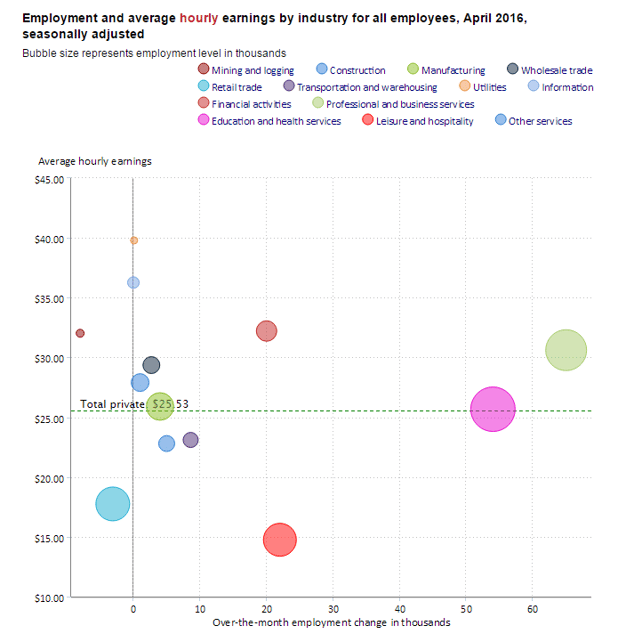
The Labor Department reported that nonfarm employment increased by 160,000 positions in April, less than the 200,000 positions consensus projection. Over the past 12 months, monthly job increases have averaged 232,000. Employment increased in in professional and business services, health care, and financial activities. Job losses continued in mining. The change in total nonfarm payroll employment for February was revised from 245,000 to 233,000, and the change for March was revised from 215,000 to 208,000.

In April, health care employment rose by 44,000. Over the year, health care employment has increased by 502,000.
The unemployment rate remained steady at 5.0% in April, the same as in March. The number of unemployed persons was little changed at 7.9 million. Both measures have shown slight movement since August.
The wider measure of unemployment, the U-6 measure, fell to 9.7% from 9.8% in March. This measure of unemployment includes those workers in part-time positions or too discouraged to look for work. The number of long-term unemployed (those jobless for 27 weeks or more) declined by 150,000 to 2.1 million in April and accounted for 25.7% of the unemployed.
Average hourly earnings for all employees on private nonfarm payrolls increased by 8 cents to $25.53 in April, following a 6-cent decline in March. Over the year, average hourly earnings have risen by 2.5%. This measure of wage growth continues to be relatively weak, despite the tightening in the labor force.

Source: Bureau of Labor Statistics
It’s likely that the Federal Reserve will regard this report as an indication of a slowing domestic economy. The April jobs number along with the weak GDP number reported for the first quarter (a gain of 0.5% at an annualized rate) will give pause to the Fed as it considers raising interest rates at its June 14-15th FOMC meeting.
About Beth Mace
Beth Burnham Mace is a special advisor to the National Investment Center for Seniors Housing & Care (NIC) focused exclusively on monitoring and reporting changes in capital markets impacting senior housing and care investments and operations. Mace served as Chief Economist and Director of Research and Analytics during her nine-year tenure on NIC’s leadership team. Before joining the NIC staff in 2014, Mace served on the NIC Board of Directors and chaired its Research Committee. She was also a director at AEW Capital Management and worked in the AEW Research Group for 17 years. Prior to joining AEW, Mace spent 10 years at Standard & Poor’s DRI/McGraw-Hill as director of its Regional Information Service. She also worked as a regional economist at Crocker Bank, and for the National Commission on Air Quality, the Brookings Institution, and Boston Edison. Mace is currently a member of the Institutional Real Estate Americas Editorial Advisory Board. In 2020, Mace was inducted into the McKnight’s Women of Distinction Hall of Honor. In 2014, she was appointed a fellow at the Homer Hoyt Institute and was awarded the title of a “Woman of Influence” in commercial real estate by Real Estate Forum Magazine and Globe Street. Mace earned an undergraduate degree from Mount Holyoke College and a master’s degree from the University of California. She also earned a Certified Business Economist™ designation from the National Association of Business Economists.
Connect with Beth Mace
Read More by Beth Mace